Climate Adaptation Plans in the Context of Coastal Settlements: The Case of Portugal
Abstract
1. Introduction
2. Portugal’s Legislative Coastal Programmes
2.1. Climate Change Effects, the Portuguese Case
2.2. Seashore Streets
2.3. Quantitative Assessment of Seashore Streets
3. Building a Methodology to Address Climate-Induced Risk Assessment, Using the Portuguese Case
3.1. Data Acquisition
3.2. Measuring Urban Form
3.3. Hierarchical Agglomerative Clustering
3.4. Sea Level Rise Scenario
4. Results: Application of the Proposed Methodology
4.1. Hierarchical Clustering
4.2. SLR Scenario—Flooded Area and Hierarchical Clustering
5. Discussion
6. Conclusions
Supplementary Materials
Author Contributions
Funding
Conflicts of Interest
Data Statement
Appendix A
| Name | Id | Cluster | Flooded Area Ratio | Wind Direction Deviation |
|---|---|---|---|---|
| Vila Praia de Âncora | 1 | B | 0.036 | 0.988 |
| Esposende | 2 | D | 0.247 | 0.959 |
| Póvoa de Varzim | 3 | F | 0.069 | 0.801 |
| Vila do Conde | 4 | F | 0.0 | 0.804 |
| Foz (Porto) | 5 | C | 0.008 | 0.567 |
| Aguda | 6 | C | 0.0 | 0.841 |
| Espinho | 7 | F | 0.0 | 0.444 |
| Furadouro | 8 | F | 0.332 | 0.279 |
| Costa Nova | 9 | F | 0.579 | 0.505 |
| Praia de Mira | 10 | C | 0.081 | 0.363 |
| Palheiros da tocha (a) | 11 | E | 0.0 | 0.346 |
| Palheiros da tocha (b) | 11 | E | 0.011 | 0.346 |
| Palheiros da tocha (c) | 11 | E | 0.02 | 0.346 |
| Quiaios | 12 | E | 0.0 | 0.259 |
| Figueira da Foz (a) | 13 | B | 0.0 | 0.66 |
| Figueira da Foz (b) | 13 | C | 0.205 | 0.66 |
| Figueira da Foz (c) | 13 | C | 0.0 | 0.66 |
| Pedrógão | 14 | A | 0.0 | 0.295 |
| Vieira (a) | 15 | E | 0.183 | 0.11 |
| Vieira (b) | 15 | A | 0.454 | 0.11 |
| Nazaré (a) | 16 | E | 0.056 | 0.385 |
| Nazaré (b) | 16 | A | 0.474 | 0.385 |
| São Martinho do Porto | 17 | C | 0.907 | 0.839 |
| Ericeira | 18 | B | 0.0 | 0.244 |
| Azenhas do Mar | 19 | D | 0.0 | 0.105 |
| Cascais | 20 | B | 0.253 | 0.35 |
| Costa da Caparica | 21 | C | 0.742 | 0.957 |
| Sesimbra | 22 | E | 0.077 | 0.592 |
| Zambujeira do Mar | 23 | E | 0.0 | 0.055 |
| Praia de Carvoeiro | 24 | D | 0.014 | 0.596 |
| Armação de Pêra | 25 | C | 0.279 | 0.686 |
| Albufeira | 26 | B | 0.023 | 0.224 |
| Quarteira | 27 | A | 0.409 | 0.754 |
| Faro | 28 | B | 0.0 | 0.508 |
| Olhão | 29 | B | 0.0 | 0.467 |
| Monte Gordo | 30 | A | 0.505 | 0.436 |
References
- Hansen, H.S. Modelling the future coastal zone urban development as implied by the IPCC SRES and assessing the impact from sea level rise. Landsc. Urban Plan. 2010, 98, 141–149. [Google Scholar] [CrossRef]
- Church, J.A.; Gregory, J.M. IPCC 2001: 11 Changes in sea level. In International Plant Protection Convention; Cambridge University Press: Cambridge, UK, 2001; pp. 639–694. Available online: http://epic.awi.de/4506/1/Chu2001a.pdf (accessed on 15 July 2020).
- IPCC (2018) Summary for Policymakers. An IPCC Special Report on the impacts of global warming of 1.5 °C above pre-industrial levels and related global greenhouse gas emission pathways, in the context of strengthening the global response to the threat of climate change, sustainable development, and efforts to eradicate poverty. In Global Warming of 1.5 °C; Masson-Delmotte, V., Zhai, P., Pörtner, H.-O., Roberts, D., Skea, J., Shukla, P.R., Pirani, A., Moufouma Okia, W., Péan, C., Pidcock, R., et al., Eds.; World Meteorological Organization: Geneva, Switzerland, 2018; p. 32. [Google Scholar]
- Neumann, B.; Vafeidis, A.T.; Zimmermann, J.; Nicholls, R.J. Future coastal population growth and exposure to sea-level rise and coastal flooding—A global assessment. PLoS ONE 2015, 10, e0118571. [Google Scholar] [CrossRef] [PubMed]
- Antunes, C. Assessment of Sea Level Rise of West Coast of Portugal Mainland and its Projection for the 21st Century. J. Mar. Sci. Eng. Int. 2019, 7, 61. [Google Scholar] [CrossRef]
- Koroglu, A.; Ranasinghe, R.; Jiménez, J.A.; Dastgheib, A. Comparison of Coastal Vulnerability Index applications for Barcelona Province. Ocean Coast. Manag. 2019, 178, 104799. [Google Scholar] [CrossRef]
- Council of the European Communities. In Proceedings of the Name of the Directive 2007/60/EC of the European Parliament and of the Council of 23 October 2007 on the Assessment and Management of Flood Risks, Strasbourg, France, 23 October 2007.
- European Court of Auditors. Floods Directive: Progress in Assessing Risks, While Planning and Implementation Need to Improve. 2018. Available online: https://www.wfcatprogrammes.com/documents/20142/34131/SR_FLOODS_EN.pdf/c296b847-db8b-6ed3-f0e3-f0c1aaab6a7c (accessed on 15 July 2020).
- Ahmadian, E.; Sodagar, B.; Mills, G.; Byrd, H.; Bingham, C.; Zolotas, A. Sustainable cities: The relationships between urban built forms and density indicators. Cities 2019, 95, 102382. [Google Scholar] [CrossRef]
- Dorrell, R.; Wentworth, J. Sea Level Rise; Parliamentary Office of Science & Technology: London, UK, 2010; p. 363. Available online: http://www.parliament.uk/documents/post/postpn363-sea-level-rise.pdf (accessed on 15 July 2020).
- Purvis, M.J.; Bates, P.D.; Hayes, C.M. A probabilistic methodology to estimate future coastal flood risk due to sea level rise. Coast. Eng. 2008, 55, 1062–1073. [Google Scholar] [CrossRef]
- Ribeiro, O. Portugal, o Mediterrâneo e o Atlântico; Coimbra Editora: Antanhol, Portugal, 1945. [Google Scholar]
- De Carvalho, L.A.N. Potential of Borehole Systems in Portugal; Lulea Tekniska Universitet: Luleå, Sweden, 2003; 2004:052 CIV; Available online: http://epubl.luth.se/1402-1617/2004/052/index-en.html (accessed on 15 July 2020).
- Ferreira, Ó.; Dias, J.A.; Taborda, R. Implications of Sea-Level Rise for Continental Portugal. J. Coast. Res. 2008, 242, 317–324. [Google Scholar] [CrossRef]
- Bigotte, J.F.; Antunes, A.P.; Krass, D.; Berman, O. The Relationship between Population Dynamics and Urban Hierarchy: Evidence from Portugal. Int. Reg. Sci. Rev. 2014, 37, 149–171. [Google Scholar] [CrossRef]
- Andrade, C.; Freitas, M.C.; Cachado, C.; Cardoso, A.C.; Monteiro, J.H.; Brito, P.; Rebelo, L. Coastal Zones. In Climate Change in Portugal—Scenarios, Impacts and Adaptation Measures—SIAM Project; Santos, F.D., Forbes, K., Moita, R., Eds.; Gradiva: Lisboa, Portugal, 2002; pp. 175–219. [Google Scholar]
- Costa, C.L. Final Report of Sub-Project a Wind Wave Climatology of the Portuguese Coast; Report 6/94-A; Instituto Hidrográfico/LNEC: Lisbon, Portugal, 1994; p. 80. [Google Scholar]
- Relvas, P.; Barton, E.D.; Dubert, J.; Oliveira, P.B.; Peliz, Á.; da Silva, J.C.B.; Santos, A.M.P. Physical oceanography of the western Iberia ecosystem: Latest views and challenges. Prog. Oceanogr. 2007, 74, 149–173. [Google Scholar] [CrossRef]
- Antunes, C.; Rocha, C.; Catita, C. Coastal flood assessment due to sea level rise and extreme storm events: A case study of the atlantic coast of Portugal’s mainland. Geosciences 2019, 9, 239. [Google Scholar] [CrossRef]
- Antunes, C.; Taborda, R. Sea Level at Cascais Tide Gauge: Data, Analysis and Results. J. Coast. Res. 2009, 56, 218–222. [Google Scholar]
- Williams, S.J. Sea-Level Rise Implications for Coastal Regions. J. Coast. Res. 2013, 63, 184–196. [Google Scholar] [CrossRef]
- Jolicoeur, S.; Carroll, O. Sandy barriers, climate change and long-term planning of strategic coastal infrastructures, Îles-de-la-Madeleine, Gulf of St. Lawrence (Québec, Canada). Landsc. Urban Plan. 2007, 81, 287–298. [Google Scholar] [CrossRef]
- Proença, S.B. Reading and interpreting Portuguese Atlantic seashore streets in sea level rise context. In Proceedings of the City Street3: Transitional Streets, Narrating Stories of Convivial Streets, Beirut, Lebanon, 31 October–3 November 2018; pp. 1–8. [Google Scholar]
- Kropf, K. The Handbook of Urban Morphology; John Wiley & Sons: Chichester, UK, 2017. [Google Scholar]
- Carneiro, C.; Morello, E.; Voegtle, T.; Golay, F. Digital Urban Morphometrics: Automatic Extraction and Assessment of Morphological Properties of Buildings. Trans. GIS 2010, 14, 497–531. [Google Scholar] [CrossRef]
- Dibble, J.; Prelorendjos, A.; Romice, O.; Zanella, M.; Strano, E.; Pagel, M.; Porta, S. On the origin of spaces: Morphometric foundations of urban form evolution. Environ. Plan. B Urban Anal. City Sci. 2019, 46, 707–730. [Google Scholar] [CrossRef]
- Fleischmann, M.; Romice, O.; Porta, S. Measuring urban form: Overcoming terminological inconsistencies for a quantitative and comprehensive morphologic analysis of cities. Environ. Plan. B Urban Anal. City Sci. 2020, 239980832091044. [Google Scholar] [CrossRef]
- Fleischmann, M. Momepy: Urban Morphology Measuring Toolkit. J. Open Source Softw. 2019, 4, 1807. [Google Scholar] [CrossRef]
- Araldi, A.; Fusco, G. From the street to the metropolitan region: Pedestrian perspective in urban fabric analysis. Environ. Plan. B Urban Anal. City Sci. 2019, 46, 1243–1263. [Google Scholar] [CrossRef]
- OpenStreetMap Contributors. 2019. Available online: https://planet.osm.org (accessed on 15 July 2020).
- Boeing, G. OSMnx: New methods for acquiring, constructing, analyzing, and visualizing complex street networks. Comput. Environ. Urban Syst. 2017, 65, 126–139. [Google Scholar] [CrossRef]
- Moudon, A.V. Urban morphology as an emerging interdisciplinary field. Urban Morphol. 1997, 1, 3–10. [Google Scholar]
- Hamaina, R.; Leduc, T.; Moreau, G. Towards Urban Fabrics Characterization Based on Buildings Footprints. In Bridging the Geographic Information Sciences; Springer: Berlin/Heidelberg, Germany, 2012; pp. 327–346. [Google Scholar] [CrossRef]
- Fleischmann, M.; Feliciotti, A.; Romice, O.; Porta, S. Morphological tessellation as a way of partitioning space: Improving consistency in urban morphology at the plot scale. Comput. Environ. Urban Syst. 2020, 80, 101441. [Google Scholar] [CrossRef]
- Usui, H.; Asami, Y. Size Distribution of Building Lots and Density of Buildings and Road Networks: Theoretical Derivation Based on Gibrat’s Law and Empirical Study of Downtown Districts in Tokyo. Int. Reg. Sci. Rev. 2019, 10, 016001761982627–25. [Google Scholar] [CrossRef]
- Colaninno, N.; Roca, J.; Pfeffer, K. An automatic classification of urban texture: Form and compactness of morphological homogeneous structures in Barcelona. In Proceedings of the 51st Congress of the European Regional Science Association, Louvain-la-Neuve: European Regional Science Association (ERSA), Barcelona, Spain, 30 August–2 September 2011. [Google Scholar]
- Steiniger, S.; Lange, T.; Burghardt, D.; Weibel, R. An Approach for the Classification of Urban Building Structures Based on Discriminant Analysis Techniques. Trans. GIS 2008, 12, 31–59. [Google Scholar] [CrossRef]
- Basaraner, M.; Cetinkaya, S. Performance of shape indices and classification schemes for characterising perceptual shape complexity of building footprints in GIS. Int. J. Geogr. Inf. Sci. 2017, 31, 1952–1977. [Google Scholar] [CrossRef]
- Schirmer, P.M.; Axhausen, K.W. A multiscale classification of urban morphology. J. Transp. Land Use 2015, 9, 101–130. [Google Scholar] [CrossRef]
- Hijazi, I.; Li, X.; Koenig, R.; Schmit, G.; El Meouche, R.; Lv, Z.; Abu Nemeh, M. Measuring the homogeneity of urban fabric using 2D geometry data. Environ. Plan B Plan. Des. 2016, 1–25. [Google Scholar] [CrossRef]
- Vanderhaegen, S.; Canters, F. Mapping urban form and function at city block level using spatial metrics. Landsc. Urban Plan. 2017, 167, 399–409. [Google Scholar] [CrossRef]
- Feliciotti, A. Resilience and Urban Design: A Systems Approach to the Study of Resilience in Urban form; University of Strathclyde: Glasgow, UK, 2018. [Google Scholar]
- Theil, H. Economics and Information Theory; North-Holland Publishing Company: Amsterdam, The Netherlands, 1967. [Google Scholar]
- Ward, J.H. Hierarchical Grouping to Optimize an Objective Function. J. Am. Stat. Assoc. 1963, 58, 236–244. [Google Scholar] [CrossRef]
- Blashfield, R.K. Mixture model tests of cluster analysis: Accuracy of four agglomerative hierarchical methods. Psychol. Bull. 1976, 83, 377–388. [Google Scholar] [CrossRef]
- Costa, J.P. Urbanismo e Adaptação às Alterações Climáticas, as Frentes de Água; Livros Horizonte, CIAUD—FA|ULisboa: Lisbon, Portugal, 2013; p. 183. [Google Scholar]
- Fu, X.; Peng, Z. Assessing the sea-level rise vulnerability in coastal communities: A case study in the Tampa Bay Region, US. Cities 2019, 88, 144–154. [Google Scholar] [CrossRef]
- Brown, K.; Naylor, A.L.; Quinn, T. Making Space for Proactive Adaptation of Rapidly Changing Coasts: A Windows of Opportunity Approach. Sustainability 2017, 9, 1408. [Google Scholar] [CrossRef]
- Costa, J.P. La Ribera entre Proyectos. Formación y Transformación del Territorio Portuario, a Partir del caso de Lisboa. Ph.D. Thesis, Escuela Técnica Superior de Arquitectura de Barcelona, Universidad Politécnica de Catalunya, Barcelona, Spain, 2007; p. 591. Available online: http://www.tesisenxarxa.net/TDX-0322107-120012/ (accessed on 15 July 2020).
- Matos Silva, M.; Costa, J.P. Urban Floods and Climate Change Adaptation: The Potential of Public Space Design When Accommodating Natural Processes. Water 2018, 10, 180. [Google Scholar] [CrossRef]
- Wilk, B.; Brown, V.; Uittenbroek, C.; Mees, H.; Driessen, P.; Wassen, M.; Runhaar, H. A diagnostic tool for supporting policymaking on urban resilience. Cities 2020, 101, 102691. [Google Scholar] [CrossRef]
- Hallegatte, S.; Ranger, N.; Mestre, O.; Dumas, P.; Corfee-Morlot, J.; Herweijer, C.; Wood, R.M. Assessing climate change impacts, sea level rise and storm surge risk in port cities: A case study on Copenhagen. Clim. Chang. 2011, 104, 113–137. [Google Scholar] [CrossRef]
- Hanson, S.; Nicholls, R.; Ranger, N.; Hallegatte, S.; Corfee-Morlot, J.; Herweijer, C.; Chateau, J. A global ranking of port cities with high exposure to climate extremes. Clim. Chang. 2011. [Google Scholar] [CrossRef]
- Park, H.; Paterson, R.; Zigmund, S.; Shin, H.; Jang, Y.; Jung, J. The Effect of Coastal City Development on Flood Damage in South Korea. Sustainability 2020, 12, 1854. [Google Scholar] [CrossRef]
- Younus, M.A.F. An assessment of vulnerability and adaptation to cyclones through impact assessment guidelines: A bottom-up case study from Bangladesh coast. Nat. Hazards 2017, 89, 1437–1459. [Google Scholar] [CrossRef]
- Schwarz, N. Urban form revisited—Selecting indicators for characterising European cities. Landsc. Urban Plan. 2010, 96, 29–47. [Google Scholar] [CrossRef]
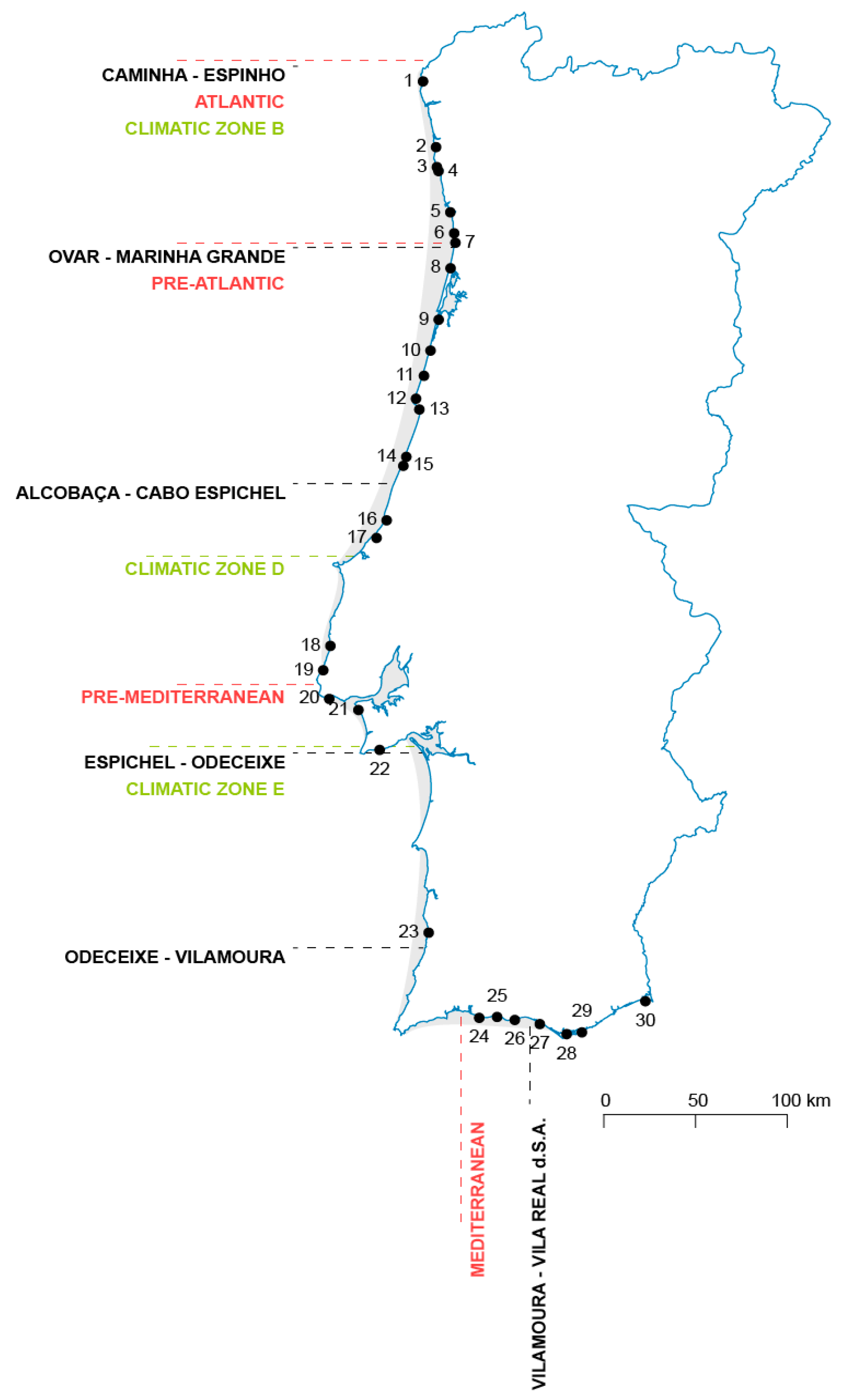
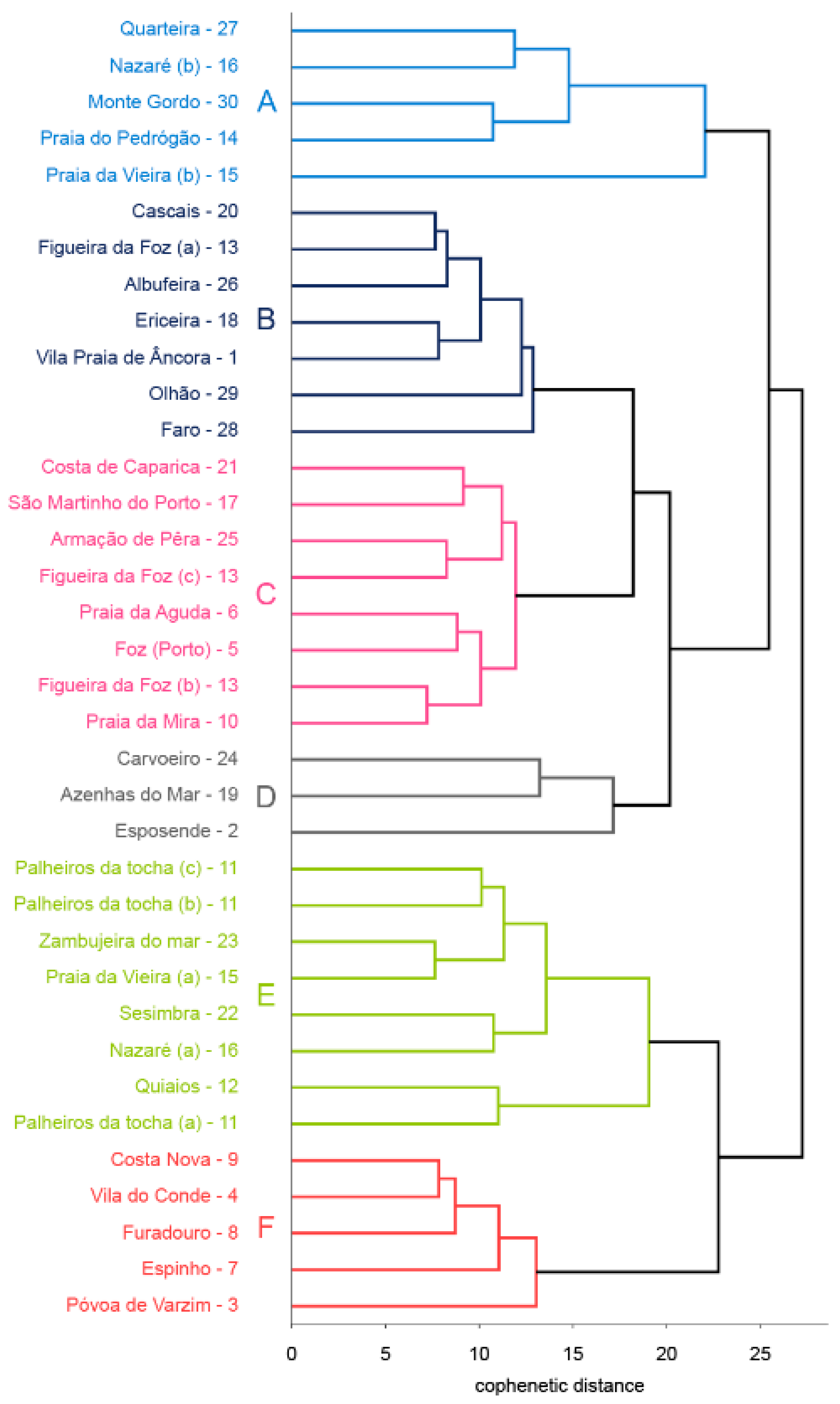
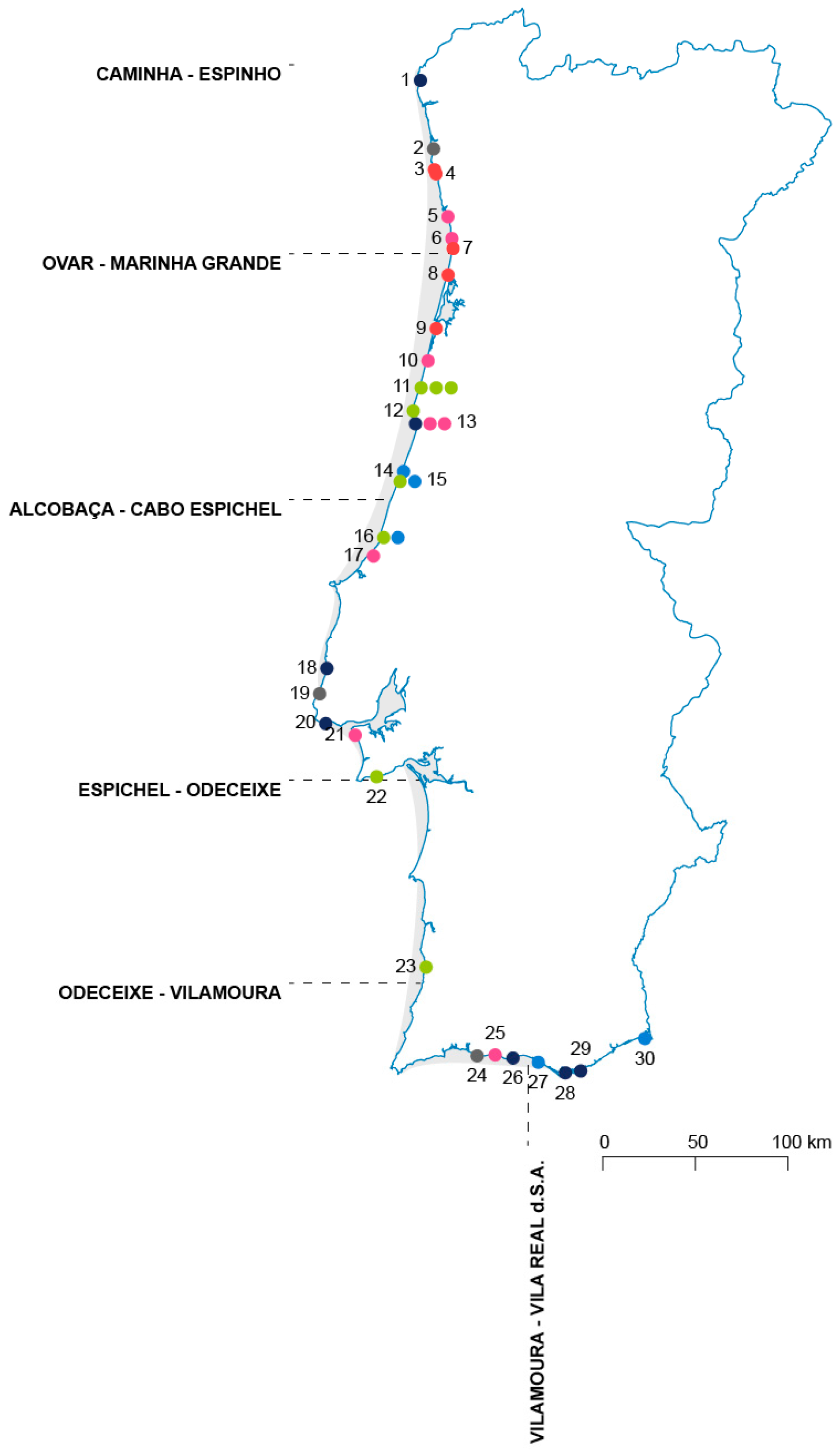
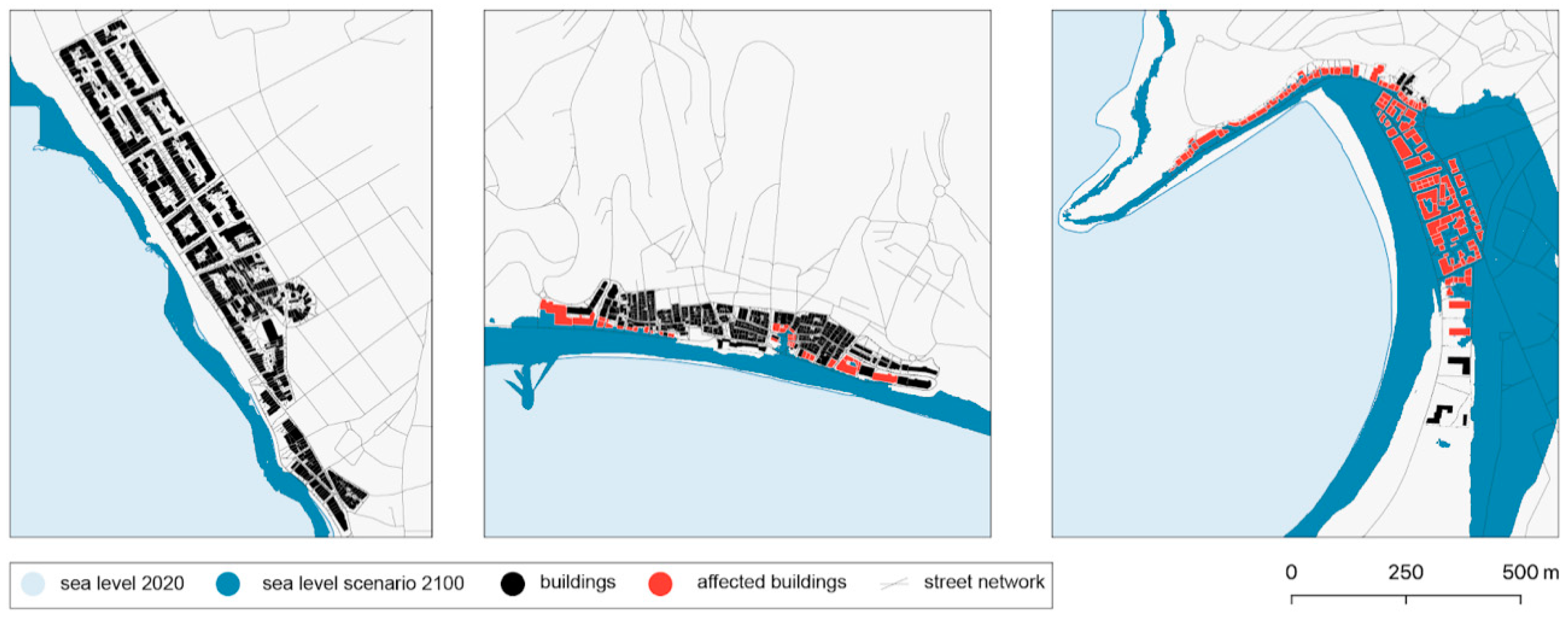
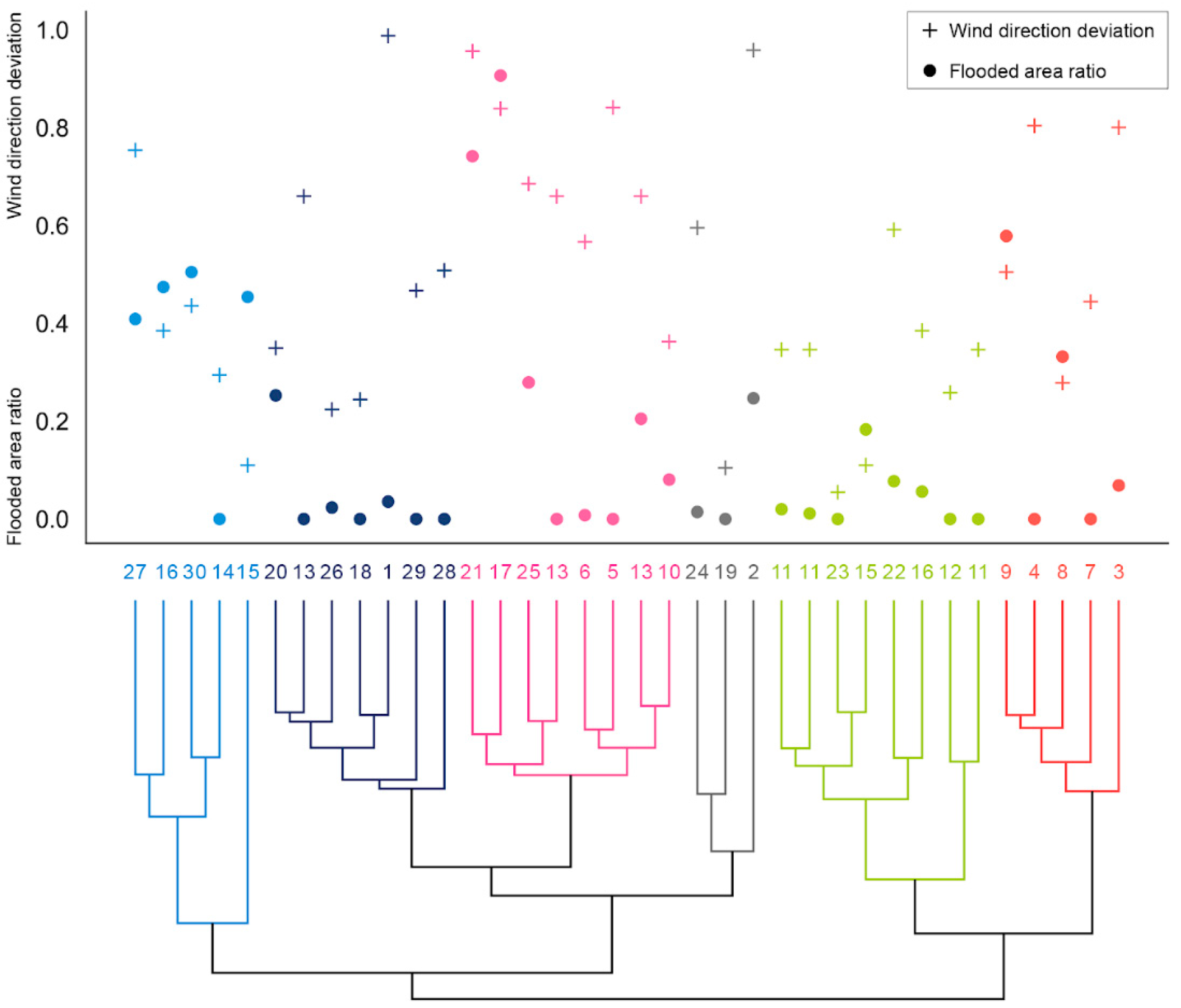
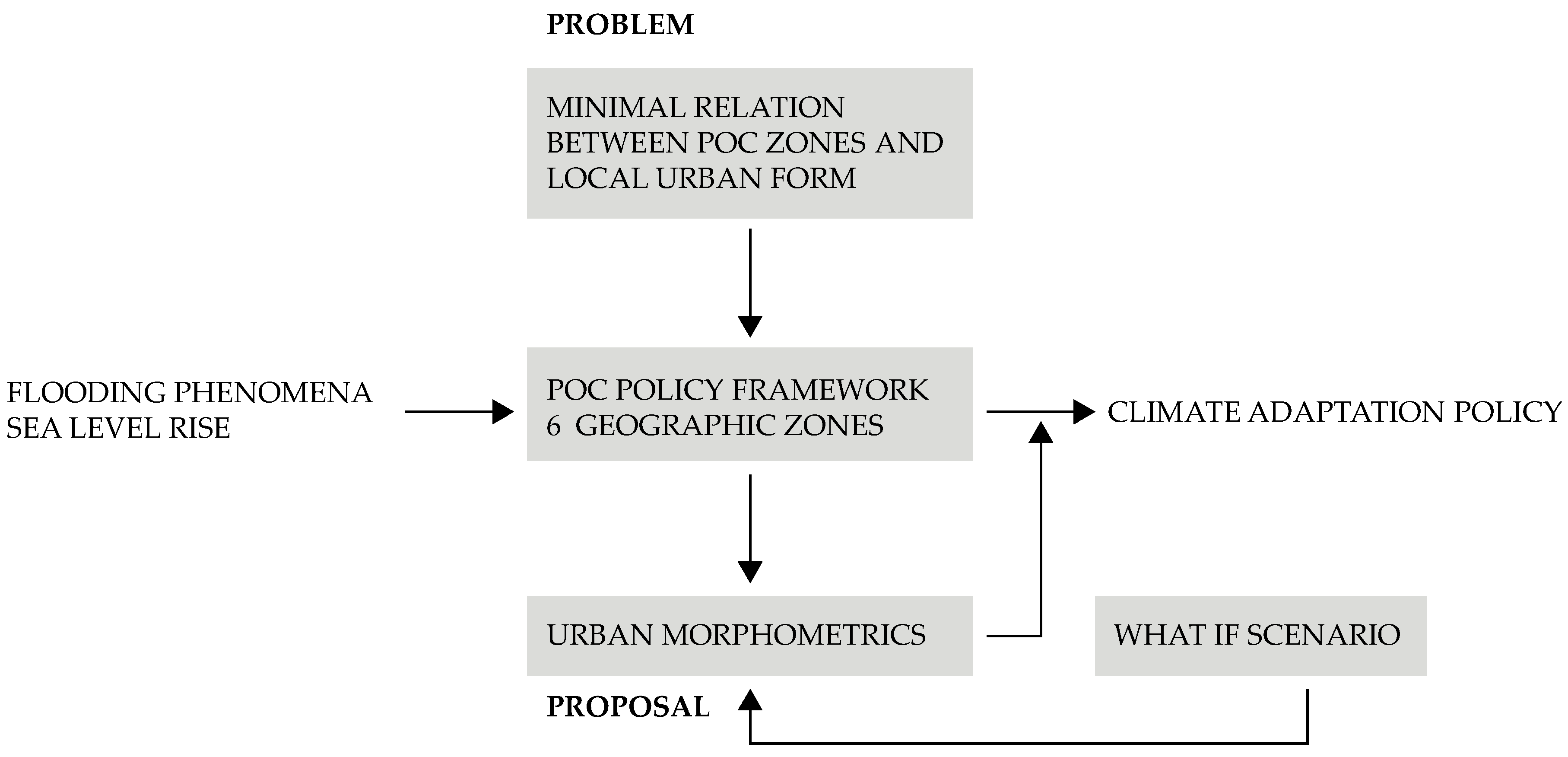
| Index | Element | Equation | Category | Ref. |
|---|---|---|---|---|
| footprint area | building | dimension | [36] | |
| perimeter | building | dimension | [28] | |
| circular compactness | building | shape | [26] | |
| corners | building | shape | [37] | |
| squareness | building | shape | [37] | |
| equivalent rectangular index | building | shape | [38] | |
| elongation | building | shape | [37] | |
| Centroid—corners mean distance | building | shape | [39] | |
| street alignment | building | distribution | [28] | |
| cell alignment | building | distribution | [28] | |
| shared walls ratio | building | distribution | [32] | |
| neighbouring buildings alignment | building | distribution | [40] | |
| interbuilding distance | building | distribution | [33] | |
| longest axis length | tessellation cell | dimension | [34] | |
| area | tessellation cell | dimension | [34] | |
| equivalent rectangular index | tessellation cell | shape | [38] | |
| street alignment | tessellation cell | distribution | [28] | |
| coverage area ratio | tessellation cell | intensity | [34] | |
| length | street segment | dimension | [26] | |
| street profile width | street | dimension | [29] | |
| linearity | street segment | shape | [29] | |
| tessellation area | street segment | dimension | [28] | |
| buildings footprint area | street segment | dimension | [29] | |
| buildings per meter | street segment | intensity | [29] | |
| perimeter wall length | joined buildings | dimension | [39] | |
| adjacency | buildings | distribution | [41] | |
| street openness | street | distribution | [28] | |
| setback deviation | street | diversity | [28] | |
| meshedness | street node | connectivity | [42] | |
| area | block | dimension | [26] | |
| elongation | block | shape | [37] | |
| granularity | block | intensity | [42] |
Publisher’s Note: MDPI stays neutral with regard to jurisdictional claims in published maps and institutional affiliations. |
© 2020 by the authors. Licensee MDPI, Basel, Switzerland. This article is an open access article distributed under the terms and conditions of the Creative Commons Attribution (CC BY) license (http://creativecommons.org/licenses/by/4.0/).
Share and Cite
Dal Cin, F.; Fleischmann, M.; Romice, O.; Costa, J.P. Climate Adaptation Plans in the Context of Coastal Settlements: The Case of Portugal. Sustainability 2020, 12, 8559. https://doi.org/10.3390/su12208559
Dal Cin F, Fleischmann M, Romice O, Costa JP. Climate Adaptation Plans in the Context of Coastal Settlements: The Case of Portugal. Sustainability. 2020; 12(20):8559. https://doi.org/10.3390/su12208559
Chicago/Turabian StyleDal Cin, Francesca, Martin Fleischmann, Ombretta Romice, and João Pedro Costa. 2020. "Climate Adaptation Plans in the Context of Coastal Settlements: The Case of Portugal" Sustainability 12, no. 20: 8559. https://doi.org/10.3390/su12208559
APA StyleDal Cin, F., Fleischmann, M., Romice, O., & Costa, J. P. (2020). Climate Adaptation Plans in the Context of Coastal Settlements: The Case of Portugal. Sustainability, 12(20), 8559. https://doi.org/10.3390/su12208559








